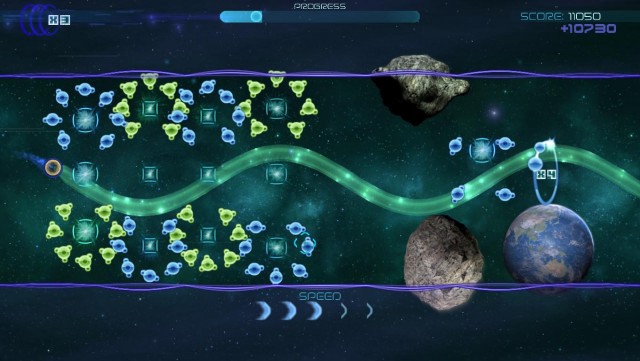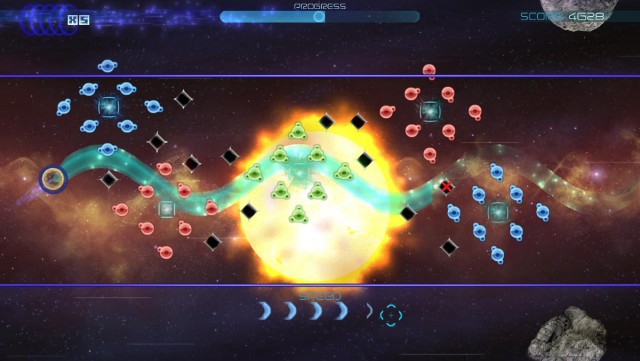The Unfunded Video Game About Shooting Light Waves Through The Galaxy
by L.V. Anderson

Sometimes, Kickstarter campaigns don’t meet their funding goals — but it’s not the end of the world! In this series we explore what happens next.
Canadian video-game programmer and designer Ryan Vandendyck came up with the idea of creating a video game centered on a wave of light about three years ago. He spent months coming home from his job as a programmer for a mainstream video-game company to work on his pet project on nights and weekends. Last November, his game nearly ready to launch for PCs, he launched a Kickstarter to raise funds to make the game playable from other platforms and tidy up its presentation. After 60 days, Ryan had received pledges for only $3,762 of his $8,000 goal.
L.V. Anderson: Describe the game for me. How do you play it?
Ryan Vandendyck: So the game is called Waveform, and it’s all about manipulating a wave of light as it’s transiting through space. So the whole control of the game is just to dynamically transform the shape of the wave, the amplitude and wavelength, to line it up with things and avoid obstacles and interact with a whole bunch of objects that you encounter as you’re moving along.
What kinds of objects do you encounter?
The story of the game — it’s kind of light on story — but the story is you’re collecting light to restore light to a dying galaxy. So you collect light orbs to get points, and if you collect enough of them you start speeding up and doing better, and then there’s dark matter that you avoid, and there’s a bunch of objects that transform the path of the wave — you can bounce off of mirrors to reflect it or enter a wormholes that warp you around. You go into black holes that are all dark, so you collect starbursts to provide light in there. There are space squid monsters that come to hurt you, so you avoid those. A whole bunch of different objects.


Did you ever try pitching the game to a larger company, or did you know from the beginning that you wanted to do it independently?
I kind of always knew that I wanted to do it independently. I did talk to people in the mainstream industry, but it was always a weird reaction. When they played it they had a lot of fun, but I think because it’s an abstract, unique concept, they’re always a little bit hesitant about if they thought it would be successful or not — whenever someone dishes out money they always want to have a lot of control, you know? I wouldn’t have been able really to make the game I wanted to if I was partnering with someone in the mainstream industry. They would have — and rightfully so; it’s their money they’re putting in — but they would have wanted to make it their own thing as well. I wanted to do it on my own for a couple of reasons. One, so I could make the game I really wanted to make and was passionate about it. And two, just almost to see if I could do it as a personal and professional challenge, to see if I was able to do it on my own and then put it out there.
Were you working on it completely independently, or did you have other people involved?
I did have a couple of other people. It was mainly me — like 90 percent or something — but some people chipped in the occasional day on the weekend or the afternoon. A friend of mine that I was working with in the industry did the composing, all the sound effects for the game. And the art; I didn’t do the art.
At what point in the process did you decide to do a Kickstarter?
That was near the end, so I think that was last October 2011. I knew I was nearing the release of the game; I was planning on releasing it either late 2011 or early 2012. I knew I was going to finish, but I was looking at the schedule and the resources I had left, and I thought that having a successful Kickstarter project would really give me that last kind of push towards release, but also maybe open some doors to deal with the game post-release.
Kickstarter only lets American residents start projects. Did you face any obstacles because you’re Canadian?
I had to go through some people I knew in the States. I don’t know too many people [there], but I do know a couple, so I had to ask, “Hey, would you let me use your bank account and your Social Security number?” and all these other things to create the account, right, which understandably is a little unnerving for some people — that’s a lot of personal information to share, right? So getting that information and getting them involved was a bit difficult, and then even after that, to be honest, I don’t even know what the tax implications would have been, because the money would have gone to an American citizen and then funneled up out of the country into Canada, so that was a bridge I would have had to cross at some point. I don’t even know all of the laws are involved there, and it didn’t really come to that, but that would have been another sort of a legal question I would have had to deal with.
Who was this incredibly generous soul who shared his or her Social Security number with you for the project?
It was a person I’d worked with at a couple of companies up here in Canada. Actually, he was working here for a while, so I knew him for like four years I worked together with him, and he also contributed on the game here and there, so he had a bit of a personal investment in wanting to see it do well anyway, so certainly that personal relationship and already [having made] his investment helped out.
And so what did you decide to do once the Kickstarter was not successful? What was your Plan B?
So, there are basically two things that I was going to use the Kickstarter money for. One was porting the game to other platforms, and the other one was to finish up the art and the presentation of the game. And so for the ports, I had to just realize that I’d handle it later and use revenue from the PC version to do that, so I had to basically push down my timetable as a priority on that one.
And then for the art and presentation, actually, a couple people that I used to work with years ago saw the Kickstarter — and you know, it was the first time they’d seen the game — but they recognized my name and really liked it and offered to get involved for a percentage of the profits after the game shipped, so I was able to accomplish that part of what I was going to do for no money upfront. So that was great.
So then where do you stand now?
Yeah, so the game just shipped, so that’s great. And over the next few months, I’m investigating and working on bringing the game to other platforms as I was originally planning on. And after that, hopefully start making the next game.
And is this what you want to do full time?
For the last three months, I’ve just been working full time on my own stuff. So I took time off from my day job. Ideally, I would like to be able to do this full time. I do like working in the regular industry as well, but certainly making my own stuff is kind of a dream come true.
Between programming and designing — I know you like to do both, but if you had to choose one, could you choose?
Yeah, I think if I had to choose it’d be design, and the reason I went into programming was to realize the designs I was already having. I think for me being able to do both is the best, because if I only do one, I get a bit frustrated. If I’m only doing design, I get frustrated at whoever’s programming it. Like, “Why did you do it this way? It’d be more fun if you did it that way.” And then similarly, when I’m programming, I’m like, “Why aren’t they making me do more interesting things? I think this is a better idea.” So yeah, I think designing is what I like most, but I’m definitely glad I can do both.
Previously: The Zombie Cookbook That Lacked Enough Live Backers
Was your Kickstarter unsuccessful? Want to talk about it? Send us an email with a link to your Kickstarter page at [email protected].
L.V. Anderson lives in Brooklyn and works at Slate.
